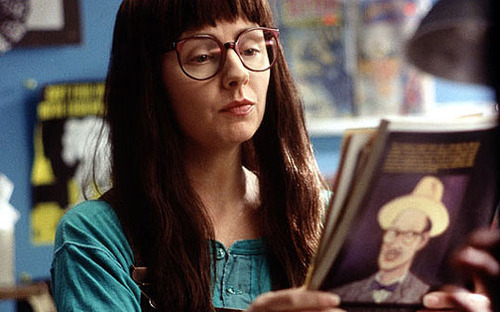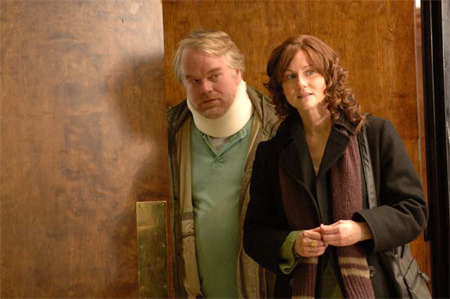The Business of Art: A Conversation with Ted Hope
A Hopeful Manifesto
Last month, Ted Hope spoke to a packed audience of NYFA fiscally sponsored filmmakers in NYFA’s new DUMBO offices. He spoke freely and frankly on the present state of independent filmmaking, and despite some recent, alarming statistics (art house film viewership is now down by 66%), his lecture was unfailingly optimistic.
Reading from pages of what might be called a Ted Hope manifesto, “Towards the New Model: Filmmaking As An Ongoing Conversation With Your Audience.” he relayed how filmmakers need to utilize social-networking technologies to form creative communities and a larger fan base, as the previous, more traditional models for funding, publicity, and distribution no longer remain viable.
What struck me the most about Hope was that he spoke without a shred of hierarchy between himself and his audience. He often used the first-person plural: “If we want to survive, we need to do this.” His democratic idea-sharing was further exemplified when, in the mist of his lecture, he handed out business cards containing a running list of his many blogs on the film industry, which he tirelessly updates daily, along with his Twitter and Facebook pages, often in the middle of the night. What follows here is a follow-up to his talk at NYFA.
Suzan Sherman: The May issue of NYFA Current featured a selection of artists coming up with innovative techniques to find arts funding and visibility, and I’d like to keep this subject going as an continuing conversation. So I’d love for us to talk about your work a producer, while also focusing on some of what you spoke about at your lecture here at NYFA.
Ted Hope: It’s such a shame that we always think there’s such a great divide between art and commerce. So little attention has been given to the kind of entrepreneurial attitude that frankly all creative people need to embrace. We have to address what the goods are that we have to sell along the way, simply for survival, and how they can be used to draw attention to ourselves for the work that we want to create. We have to recognize that for all the opportunities and freedoms we have in living in this country, complete and utter self-reliance is also required. I’ve made 60 films, but frankly I prefer to think of them as 60 different startups. They’ve each been new business enterprises that I’ve had to engage with from the very beginning. Yes, they’ve been incredibly self-expressive and adventuresome in spirit, but in some ways (maybe this is the benefit of film, being truly at the crossroads of commerce and art), they’ve been strategized on how they can turn a profit. And my ability to do that is how I’ve had a prolific career.
SS: Besides the potential for making money, what are some of the other elements you look for when considering projects?
TH: I’m very much aware of how much is already out there. My Netflix cue is maxed out; my wife’s Netflix cue is maxed out; and my eight-year-old son is over halfway there. We have enough stuff to watch every night of the week for the next five years. When people put an appropriate value on their time and actually recognize there is an opportunity cost to everything that we engage in, we slowly begin to move away from being an impulse society to one of choice. You factor in cable TV, television, the Internet, everything that is competing for our attention now, and so when I choose a project—how’s this for the long way around answering a question?—I have to be conscious that I’m looking for something that is going to cut through and surpass in desire all those pre-existing movies, and all the ones that people have yet to watch on their own Netflix cues.
First and foremost, I’m looking for things that are going to make themselves distinct in the marketplace. I’m not interested in a story I’ve seen before, no matter how well it’s told this time. I’m not interested in films that rely on the same story-telling methods. Filmmaking has been around for a hundred years—isn’t it time that we moved the methods forward a bit? I’ve seen time and time again when films are made well, ones that either tell a new story, or tell a story for an audience that hasn’t been served before, or tell a story in a new, particularly fresh way, they do catch on and become what people most want to see. And it’s also a question of who is involved in the team—the director, the collaborators, and if I feel that they have a distinct voice and a body of work to come.
SS: But how can you know if a filmmaker has future potential? How can you foresee something like that?
TH: There are some people who are eternal students, and are looking to grow and change with all the work that they do. That’s the attitude I’m looking for. There are those who clearly have multiple stories to tell, and who are looking for ways to get their unique personality into the work they’re doing. I’m very proud that all of the movies I’ve been associated with come from a distinct voice; you look at those films and feel that only that director could have been the one that made that film. They don’t feel committee made, they don’t feel generic. They feel infused with the personality of the director, and I find that a really exciting phenomenon. I like a strong point of view and a bold expression of self.

SS: You also produce films predominantly peopled by unconventional characters, and/or characters I’ve not seen before. As a viewer I feel glad that I’m seeing them; they’re a reflection of aspects of myself and certainly other people in the audience. Could you speak to that a bit? Because that’s something you spoke about at NYFA, but in a different way, about breaking down the boundary between film and audience.
TH: Early on, in my youth, I had the benefit of seeing foreign films of a really intimate, personal nature and they really spoke to me. And film as a form spoke to me by its combination of tools—sight, sound, time, edit, manipulation of space, all of that, and that it could create an incredible amount of empathy and realistic sensation, allowing us to recognize ourselves in people that we ordinarily may not have any contact with or even think are a bit like us. I found that, and still do, incredibly profound.
It was a mixture of having that sort of background, and then coming of age when punk rock broke, and seeing how it provided a real alternative to what was for me a corporate, soul-less form of music. Maybe it didn’t have the same technical skill of production craft, but instead punk offered up a spirit and personality, and a healthy dose of antagonism that I found really liberating. I began asking myself how I could marry that do-it-yourself aesthetic with the deeply personal cinema emerging abroad.
And it so happened that I moved to New York right when She’s Gotta Have It, Stranger than Paradise, and Blood Simple all were hitting the screens. I was partially inspired to a move here after seeing Susan Seidelman’s Smithereens and knowing that John Sayles was here, and just feeling like that’s the type of filmmaking I’d like to do. The characters in those movies were the people that I knew; their stories could have been pulled from pages of my life, and I always felt like that was incredibly empowering, when we as viewers can feel that—feel that our stories are heroic, and worthy. So that was the train I wanted to cover and dramatize—that which could get even realer, truer, when emotional content didn’t feel it was in service of the plot but was real to the richness and complexity that is the human experience. That’s been a real goal of mine. So many other films diminish that.
SS: So you knew that you wanted to get into the film industry. But why did producing make sense to you, as opposed to directing or cinematography?
TH: There were a couple of reasons. I came to NYU undergrad, transferring into the film school. I had been doing community organizing and referendum initiatives and campus organizing prior to that. And I had gotten frustrated with the path to social change because the process felt, one, incredibly slow, and two, not necessarily getting to the roots of where many of the problems lay. I first thought when I went to film school that I was going to make documentaries of a political and social-activism nature. But I was very frustrated that the audiences for those films were only looking to have their point of view reconfirmed. They didn’t want to engage in a conversation, they didn’t want to engage in debate. They were looking at these films as a way to keep them in the same place rather than move forward. After directing some experimental films, I started thinking much more about narrative, and mainstream narrative really allows you to have more of conversation by offering other pleasures along the way.
Because of my organizing background (it was something I also often did as a child, organizing the baseball games in our neighborhood or coming up with whatever plan it was) filmmaking was second nature to me. But when I was making narrative films, I wasn’t necessarily seeing all of the nuances in every shot, all of the components simultaneously. But I could see the construction of them, and what was necessary. And it started to feel that I had more to offer in being the one that put the agenda forward in terms of what needed to be done and when, and not necessarily the one that conceived of it all. And that skill set seemed to be in short supply, and something that many people were hungry for. And because I had strong opinions of what made good films, it allowed me to sift through people much more quickly. So when I saw the first work of Nicole Holofcener, Ang Lee, Hal Hartley, Todd Solondz, and Todd Field, it was clear to me that these were world-class directors who would go on to do great work.

SS: This card of yours that you gave out at the lecture—there are seven blogs listed here.
TH: Two of them have since combined into one. I’ve moved Letmakesbetterfilms to the Hammertonail site.
SS: Why do you blog? Why share your ideas with other filmmakers? When you spoke at NYFA, I sensed a number of people in the audience were initially resistant. It relates a bit to what you were saying earlier, when you were making documentaries and feeling like you were speaking to the converted and being hungry for a more transformative experience. That was happening the night you came to NYFA. The filmmakers in the audience didn’t want to think about their work differently, or think about anything besides making films. But I could feel them softening by the end of your lecture and it was incredible to watch that.
TH: First of all, I’ve always felt fortunate that I came to New York, and that I stayed in New York. It feels like much more of a culture here than elsewhere—not just in this country, but abroad too. It’s been so much harder to get our movies made. I think people have recognized, uniformly almost, that we all are in it together. Generally there’s been a lot more information sharing here than I understand it to be elsewhere.
But beyond that, I can’t move fast enough for my desires. I can’t get enough done. I can’t bring the arguments ahead as quickly as they need to right now. I feel like we’ve all been drinking the Kool-Aid and thinking that the world is a fine place for far too long, and it doesn’t benefit the culture in any way. It slows things down and people get seduced by paychecks or acclaim. How do we remain true to a Platonian ideal or to the fact that we can get to better work in more inventive ways, more economically, more efficiently? We don’t have enough insight. We need to be a multi-headed beast, a hydra that is pulling all of this information in, willing to fail, but in process gaining by the mistakes as well as the successes. You can’t talk about that and not do it yourself.
When I started out in the film industry, I really resented how closed down it was. It took me a long time to find people who were willing to walk me through what a stripboard was, a schedule, a budget, and all of that information. The Internet didn’t exist. The amount of education and tools out there didn’t exist. It made it really hard. I was a PA for three years, which is longer than most people. I was very happy doing it, but some of it was that it was really difficult to get my hands on information that would allow me to be of service in a greater capacity. And I think that in this moment of profound paradigm shift that the business is going through, we lose sight that there’s the real potential for a similar paradigm shift in terms of content. The possibility of marrying those two things, of not looking at it as a woe-is-me scenario, but instead recognizing this time as a real opportunity to get fresh blood and new voices and new forms out there is so exciting. But again, there’s no such thing as the singular hero that’s going to lead the way. It’s going to come from a lot of people who do good work, not great work, but are building on each other. But there will be those few things that come along—that person that bursts out, the team that bursts out and does that remarkable trans-media open-source thing that somehow has figured out some tricks to actually make some money along the way. It’s not their genius, it’s that they are able to build on the work of others. I’ve seen that in smaller ways many times, and though I hope to be there on the forefront, I’d be very happy to lift others up along the way too.
SS: I was pretty shocked by some of the statistics you spoke about—art house film viewership is down by 66%, while mainstream films are up 16%
TH: That was in Peter Bart’s column in Variety.
SS: Could you describe how the temperature and tone of Hollywood has changed, and if your push for filmmakers to create new models is more than a reaction to the recession.
TH: It’s not just the economy. It’s the competition for eyeballs. We’ve watched gaming grow and grow. We’ve watched online viewing increase 700% on an hourly basis since last year, and viewership is up 82%. Very big numbers. So many different things are out there, and at the same time I think people have to look at how everything is interconnected. The collapse of print journalism brings down with it the delivery mechanism of how upscale films, specialized films, reach their audience. Most people were informed by both what they read and saw in print. And that space becomes both more valuable and less valuable; the stuff that is being read is more valuable, thus more expensive, and there’s less access and ways to do it, so it’s also less valuable.
It’s not a big stretch to recognize that those investing millions upon millions of dollars into creative content want things to be safer and safer, generally speaking. Both domestically and internationally there have been a series of events and trends that have all made it initially appear less lucrative. There are also the positive aspects too. At the beginning of the year there was so much negative conversation about the future of media that I decided to sit down and write out 52 things that seemed positive on my Trulyfreefilm blog, and that didn’t even account for audience growth and increased ticket sales for theatrical product this year, which has remained on a pretty healthy pace. But it does all point to the fact that you have to find new ways to excite audiences. The days of just making a good movie that feels hand-crafted—you’re not going to be able to build the support. There’s too much other stuff that’s out there. You’re not just competing with the new. In a pre-digital age, we always needed the next new thing. We don’t need that anymore, because things last forever, and so you’re competing with the greats through the history of time.

SS: Back to the idea of the audience. I pulled a quote from your talk at NYFA: “If a diverse film culture is gong to flourish in this country, we have to move to a model where filmmaking is a process, an ongoing conversation between filmmakers and their various audiences.” Could you elaborate a bit more on how this relationship can be a dialogue.
TH: As much as I love watching movies, I actually love talking about them more. I think the best definition I ever heard for an art film is a film that compels you to talk about it afterward. It’s not just like thumbs up, or it was good. It’s that the ideas and emotions and artistic elements expressed on the screen forces you to talk. And I think that one of the things that’s happened over the last decade is that the specialized film industry adopted Hollywood’s marketing methods. They went to saturation-release strategies and marketing spends. It was about the easiest, quickest way to reach and draw that audience in. And by doing so, they allowed the various community aspects of cinema to wither and rust.
We now have an incredible tool for dialoging and community and organizing in the Internet. The mainstream industry has to repeatedly adopt more risk-adverse content and methods of release. The ability to tell distinct, unique stories in distinct and unique ways is going to become much more based around the relationship between a creative team and its audience. And a lot of that will be based around filters and curators that can drive audiences to good work.
That might be something akin to newspapers and magazines, sometimes it’s going to be much more personal, through social networks or blogs, but we’re going to watch that model start to change. If you look at other creative industries, certainly music, the more that you can offer your fans and your audience in terms of an engaged experience, the richer that relationship is and the more reliable it will be in terms of its desire to engage or consume. And often the common focal point will be that prime work— a feature film, maybe a short film, or a live event of some sort—but the experience that community has around that unifying hub will be what extends beyond that. The phenomenon of fan fiction speaks well of how those that are “outside the process,” can contribute to the process. Granted, most of this has already taken place in geek culture, sci fi, horror, and fantasy, but there’s been so many riffs. And that back and forth, and our ability now to self-broadcast and distribute and promote, can increase a great deal, so there can actually be a back and forth between the originator and those that engage in it. And the creative power of that has not even begun to be tapped. As filmmakers, that’s what we want to start to look at—how it’s not just each film building the wheel again, but how can we look at our mutual bodies of work as different points of access to engage in an ongoing conversation.
Ted Hope is an independent film producer based in New York City. He has produced the first films of such notables as Hal Hartley, Nicole Holofcener, Todd Field, Michel Gondry, Moises Kaufman, Bob Pulcini, and Shari Berman, among others.





